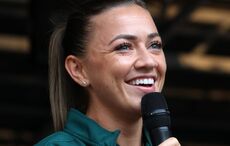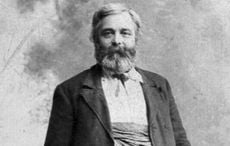Australia and Ireland said farewell to Jim Stynes at a state funeral in Melbourne on Tuesday, with thousands gathering at Federation Square to celebrate his life as the ceremony was held at nearby St Paul’s Cathedral.
Stynes, the Dublin giant who paved the way for more recent GAA-to-Australian Rules converts like Kerry’s Tadhg Kennelly and Down’s Martin Clarke, died recently after a long and very public battle with cancer. He was just 45.
How good an Australian Rules football player was Jim Stynes? More importantly, how good a man was he?
Putting his achievements into perspective is difficult for the simple reason that nothing like what he did had ever been done, until he did it. Heading to Australia at just 18 in 1984, he not only starred for Melbourne in the Australian Football League (AFL), he became one of the game’s greats, re-defining the mobile ruckman role.
Winning the Brownlow Medal for “best and fairest” player in the league in 1991 (the only non-Australian to do so), he also claimed four Melbourne best and fairest awards, and twice made the All-Australian team. Setting a record for consecutive AFL games (244), he played 264 games in total, was named in Melbourne’s Team of the Century, and was inducted into the AFL Hall of Fame.
“That he eventually debuted as a Melbourne player in 1987 was admirable,” former teammate Garry Lyon said at the Irishman’s funeral. “That he was the best and most dominant Australian Rules footballer in the country four years later was to begin to understand and appreciate the sort of athlete and person we were dealing with.’’
But ironically Stynes’ impact off the field was even greater.
He is credited with saving his financially crippled former club when he took over its presidency in 2008, but his main life’s work away from the football field had been with the Reach Foundation, an organization he co-founded in 1995 which promotes the mental health and wellbeing of young people, with the aim of seeing them fulfill their potential.
His work with Reach, estimated to have impacted some 500,000 youths, saw him named Victorian of the Year in 2001 and 2003, and awarded the Medal of the Order of Australia in 2007. In a moving tribute days before the funeral, Lyon, himself an AFL great, said Stynes had made him re-think what life was all about.
“I now see the irony, in that I was to become the leader of the football club, and help set a standard for others to follow, while all the while it was Jim who was doing the real leading and setting the real standard,” he said, choking back tears.
Describing being initially skeptical when Stynes arrived, he said the Dubliner soon shattered his illusions.
“He fulfilled all of my pre-conceived notions of what an Irishman should be. Pale, lean, and with an accent that was perfect for telling Irish jokes. Beyond that, I didn’t give him too much thought. My mind was captivated by the ‘real’ footballers at our club.
“How did it come to pass, then, 27 years down the tracks…that the Irish curiosity that I first encountered in the car park outside the MCG [Melbourne Cricket Ground] was to become and will remain the person that I judge and measure myself by?”
Amazing words, but this is an amazing story, and it’s one that often reminds me of another unlikely tale, albeit a less dramatic one.
In 2004 at my home GAA club in Co. Galway, Salthill-Knocknacarra, we went close to winning a county title with an Australian in our ranks. On a globe-trotting working holiday, Paul Kennedy (PK, as he is known) was laboring on the building sites of Galway with some GAA men and figured he’d like a shot at this Gaelic football craic.
He had played in the Victorian Football League (VFL) in his homeland, the semi-pro feeder league of the AFL. In typical Irish fashion, either nobody believed him, or they failed to understand the significance of this, so all it earned him was an introduction to the game via our Junior C team, the lowest rung on the ladder. Within weeks, however, it was apparent that this was no ordinary player; PK had soon jumped three teams and was lining out for the seniors (first team), used as a third midfielder.
The most likeable guy you’d ever meet, he became a huge part of our squad from the outset, and was eventually recognized as one of the best players in that year’s Galway Senior Championship. When it was all over and the team was giving him a send-off as he headed back to Australia, he remarked how overawed he had been by the whole experience. Like Stynes when he was starting out, PK often said that he had carried a fear of making a crucial mistake at his adopted game, and costing the team.
We needn’t have worried; all he ever did was win games for us, and word soon went around of “this Aussie lad playing for Salthill.” At a club known and heavily criticized - wrongly, we would argue – for fielding so-called “outside” players, you could have said this was the last thing we wanted; talk about giving ammo to our critics! In fact, though, PK was exactly what we needed.
His will to win and professional approach honed in the VFL were infectious. He nit-picked his own game beyond belief, constantly sought out advice, was never afraid to speak his mind though he was a GAA novice, and even gave us a few tactical changes transplanted from the Australian game to better our unit. By season’s end, he was one of our leaders.
Impossible to beat to a breaking ball, his foot-passing wasn’t exceptional but he could fist-pass the ball such lengths and with such incredible accuracy that it didn’t matter. We lost that year’s county final; PK’s benching on 49 minutes was seen as a tactical error which contributed to our losing the game, as we imploded once he went off.
In 2008 when another clubmate of ours, Finian Hanley, represented Ireland against Australia in the International Rules series held in Melbourne, it seemed like half of Salthill was in the city. We all went along to the game at the MCG with PK, who was at that stage back playing his native sport.
By then living in Melbourne, a cousin and I traveled down the coast regularly at weekends to watch him play in the VFL for his club, Frankston. It turned out he was – and still is – an exceptional Australian Rules player. He hadn’t been having us on, after all.
You can be sure that when PK first thought of playing Gaelic football in Ireland, Jim Stynes’ story would have made him think it was possible that he could excel at an alien game in a faraway place. Likewise you can be sure the impact Stynes made was not lost on either Tadhg Kennelly or Martin Clarke when they decided to pursue their dreams in the AFL.
The words “trailblazer” and “pioneer” seem like huge understatements when describing someone who proved just how much can be achieved in a human lifetime, even one cut cruelly short. We must remember, too, just how crazy a concept it must have seemed to Stynes’ family - even one so steeped in the GAA - when the 18-year-old answered a newspaper advert in Ireland and soon found himself 10,000 miles away from home. Not only did he pull it off – he became a legend.
“I had this awful fault of hammering him before anyone else, and in front of everyone,” Jim’s father Brian said in an incredibly intimate documentary made on Jim’s battle with cancer. Describing his own ruthless pitch-side manner during Jim’s younger days, he said that though he felt guilty for doing it, it did have the desired effect on his son. “It made him tough,” he said.
Another huge understatement.




Comments